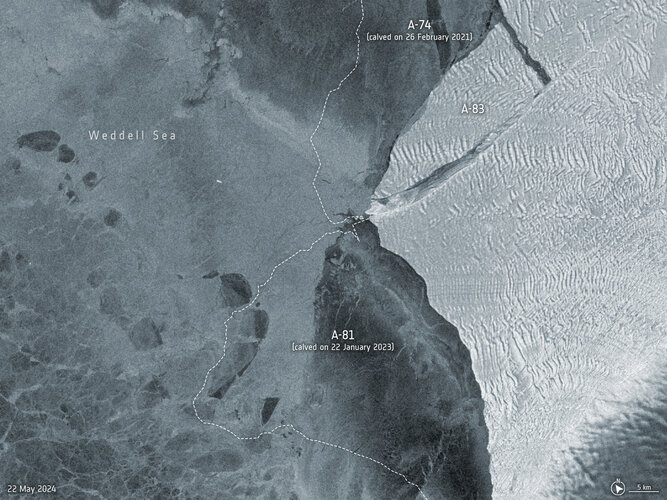An iceberg roughly the size of the Isle of Wight has broken off the Brunt Ice Shelf in Antarctica on 20 May.
This calving event results from a prolonged weakening of the ice at the McDonald Ice Rumples and progressive eastward extension of the so-called ‘Halloween Crack’ into the ice shelf.
The separation of iceberg A-83 marks the third significant iceberg calving from this region in the past four years. In 2021, the Brunt Ice Shelf produced an iceberg called A-74 followed by an even bigger berg, named A-81, in 2023.
The radar image on the left, captured by the Copernicus Sentinel-1 mission, shows the 380 sq km triangular iceberg on 22 May 2024. The thermal image on the right shows brightness temperature data from the US Landsat 8 mission.
Thermal image data helps with the characterisation of ice thickness. The thinner the ice, the warmer it appears in the image, making it closer in temperature to open water. Conversely, thick, continental ice registers as extremely cold. The temperature differences between water and ice help also with identifying where the calving line is exactly.
The iceberg has been officially identified as A-83 by the US National Ice Center. Antarctic icebergs are named from the Antarctic quadrant in which they were originally sighted, then a sequential number, then, if the iceberg breaks, a sequential letter.
Brunt is located in the eastern Weddell Sea, so its bergs receive an ‘A’ designation and 83 is the next number in the sequence of icebergs calving in this sector.
The calving does not pose a threat to the presently unmanned British Antarctic Survey’s Halley VI Research Station, which was moved in 2017 to a more secure location after the outer ice shelf was deemed unstable.
Routine monitoring by satellites offer unprecedented views of events happening in remote regions like Antarctica, and how ice shelves manage to retain their structural integrity in response to changes in ice dynamics, air and ocean temperatures.
The Copernicus Sentinel-1 mission carries radar, which can return images regardless of day or night and this allows us year-round viewing, which is especially important through the long, dark, austral winter months.



 Image:
An iceberg roughly the size of the Isle of Wight has broken off the Brunt Ice Shelf in Antarctica on 20 May.
Image:
An iceberg roughly the size of the Isle of Wight has broken off the Brunt Ice Shelf in Antarctica on 20 May.